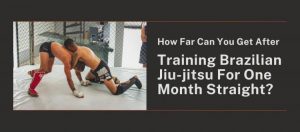To become a complete jiu-jitsu practitioner, you must learn takedowns. You don’t have to know all of them, but you do have to have a few to fall back on when you need it. Whether it be in sparring or real-life situations, learning takedowns is an essential part of any grapplers skillset.
Getting the opponent to the ground is always the first goal of the jiu-jitsu practitioner’s game plan. Having a few options at your disposal will ensure a higher chance of outplaying your opponent and getting the upper hand at the start of the match. Plus points if you can finish your takedowns in passing position.
Nogi takedowns are especially applicable in MMA and on the streets because you will not have solid cloth to use for grips most of the time. In this article, we will give you the 5 easiest no-gi takedowns to learn for BJJ practitioners.
Double leg
The double leg takedown is one of the most famous takedowns in grappling and MMA in general. When you ask a beginner what takedowns they know, the double leg will always be the most common answer, and for good reason. It is a powerful and fast takedown that is hard to stop when you get caught off guard. Jordan Burroughs, an Olympic freestyle wrestler, is known for his powerful double legs that won him the gold medal in the 2012 London Olympics.
When should you use it?
The double leg should be used when you find your base lower than your opponent’s and you are in proper distance to make a shot. You can check if you are in shooting distance if you can reach his head with your extended arm.

Why is it effective for Nogi?
The double leg is a high percentage takedown that is harder to commit to when you are in the Gi. Grabbing onto the material of the gi while performing a sprawl makes it almost impossible to get taken down if you timed the sprawl perfectly. Nogi eliminates that problem entirely.
Underhook to Single leg
This is one of the easier entries to the single-leg takedown. Getting at least one underhook on your opponent gives you great control over their movements. They won’t be able to lower their base, and you will be safe from a lot of lower body takedowns.
When should you use it?
You should use this takedown when you have an underhook on your opponent and you find the same side leg in range for you to catch for a single leg. Remember to be mindful of your neck as your opponent might catch you off guard with a guillotine. Keep the pressure of your head on his rib and you will be safe.
Why is it effective for Nogi?
Since you don’t have the gi material to grab on to secure your takedowns, a lot of the control you will have comes in the form of underhooks. Use this to your advantage by always fighting for at least one underhook, then setting up this quick and easy takedown.
Arm drag to single leg
The armdrag is a staple technique in freestyle and greco-roman wrestling. It serves its purpose as a means to control your opponent and set up for powerful takedowns. In Jiu-jitsu, you have a lot more options as it is the perfect setup to get the back from any angle.
When should you use it?
You should use the armdrag when you feel your opponent pressuring forward toward you. Cup your opponent’s opposite arm and redirect his force, pulling yourself forward in the process. Going straight for the single leg is the optimal choice to follow up after the armdrag. Remember: When doing the armdrag, you are simultaneously pulling yourself in while pulling your opponent towards you.
Why is it effective for Nogi?
The armdrag is effective due to the power of the two-on-one grip you impose on the opponent’s arm. You are able to manipulate their weight and get yourself positioned behind them, ready for a takedown or back take.
Ankle Pick
The ankle pick is just as good in jiu-jitsu as it is in freestyle wrestling. It is used by a lot of grapplers today because of your ability to shoot from range and still end up in passing position. This is crucial to becoming a well-rounded grappler, especially if you want to compete.
When should you use it?
The ankle pick should always be an option when your opponent is posturing up a little too much. Pull his head downwards to get an upward reaction that you will use to drive him forward. Extending your arm forward while getting the ankle pick ensures he wont be able to sprawl in time. Just be careful of the armbar, as this move leaves your arm exposed when pushing forward.
Why is it effective for Nogi?
This move is highly effective in nogi as you can instantly sweep your opponent’s leg if you are able to catch their heel fast enough. It is difficult to escape, especially when you raise their leg above their head.
Underhook to Kouchi Gari
Kouchi Gari is one of the 40 throws of Judo developed by Jigoro Kano, the founder of Judo. This Judo-derived technique involves reaping the opponent’s heel in a scooping motion to break the balance and get the fast takedown. It is an easy to perform and high percentage takedown that requires proper timing and a good understanding of weight management to pull off.
When should you use it?
You should use this technique with you are up close and have a firm underhook on one side of your opponent, with the opposite hand cupping the opposite arm for stability. The perfect time to go for the kouchi-gari is when you feel that their weight is pressed down on their heels. All their weight will come crashing down when you break one of the two bases, which is their feet.
Why is it effective for Nogi?
The Kouchi-Gari is a great takedown for nogi because it catches your opponent off guard. Remember, the control with the underhook is the key so your opponent cannot disengage. Their legs become vulnerable to sweeps and trips in this position.



